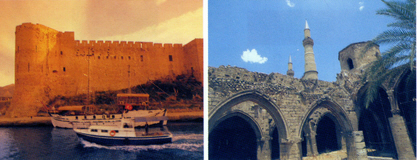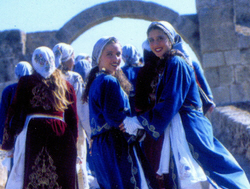Readers may recall that at Easter 2010 I was privileged to take a cruise retracing the extraordinary journeys of St Paul in the 1st Century AD, including visits to Syria and Libya that would not be possible this year! This year I was at long last able to fill the gap in this odyssey when in June I was finally able to visit a place virtually inaccessible to us since 1973, with a ‘proximity agreement’ that took a decade to finalise now enabling free open stays in the Turkish Republic of Northern Cyprus. This island bears all the marks left by Phoenicians, Assyrians, Greeks, Egyptians, Persians, Romans - and the British! Left is a wealth of history, architecture and art at which to marvel. I concentrated on the legacy left by the Romans, Crusaders and St Paul, St Barnabas and John Mark. The outstanding historical sights are the Crusader castles at Kantara and St Hilarion, where Richard the Lionheart married Berengaria, who thus became Queen of England but never actually reached here, Kyrenia Castle and Salamis. This is the well preserved Greco-Roman city where St Paul, Barnabas and John Mark arrived in AD45. Barnabas was born and died here. He is buried, together with the copy of St Matthew’s Gospel that he always carried, in nearby St Barnabas Monastery, which contains a huge collection of Saints’ portraits - including six of St George! The highlight of any visit to Cyprus is the lovely Bellapais Abbey (location of Lawrence Durrell’s “Bitter Lemons”). The whole setting responds to the name of Abbeye de la Paix, Abbey of Peace - the symbol for communities to live in peace with each other, not just here but all over the world. It was slightly disconcerting to visit the striking St Nicholas Cathedral in Famagusta, now the Lala Mustafa Pasha Mosque, and similarly St Sophia Cathedral, now in the Turkish quarter of Nicosia and hence rebranded as the Selimiye Mosque.
Even for the non-Christian visitor, Northern Cyprus is a gem - the Mediterranean as many of us used to know it, blessed with stunning scenery, excellent beaches and towns and resorts with plenty of character. I had the pleasure of staying in the attractive town of Kyrenia, with its film-set picture postcard perfect harbour, which is transformed into a fairyland after dark with all the waterfront restaurants candlelit and the floodlit castle at one end. Northern Cyprus has the best of three worlds, Turkish, Cypriot and a strong residual British presence. 37 years after partition driving is still on the left, they use our 3-pin sockets, post boxes (albeit painted yellow) and phone booths. English is universally spoken, widely used in signage and always on restaurant menu boards. The currency in use is the Turkish Lire which makes spending very inexpensive (eg a good lunch a pint of beer, with splendid view, for just over a fiver!)
These two trips, whilst providing superb holidays, have left upon me an indelible impression of St Paul, this incredible man whose mandate was to stamp out (as Saul of Tarsus) this new, upstart religion, but instead, over the course of four remarkable journeys, converted the known world to Christianity.
Vic Brown






